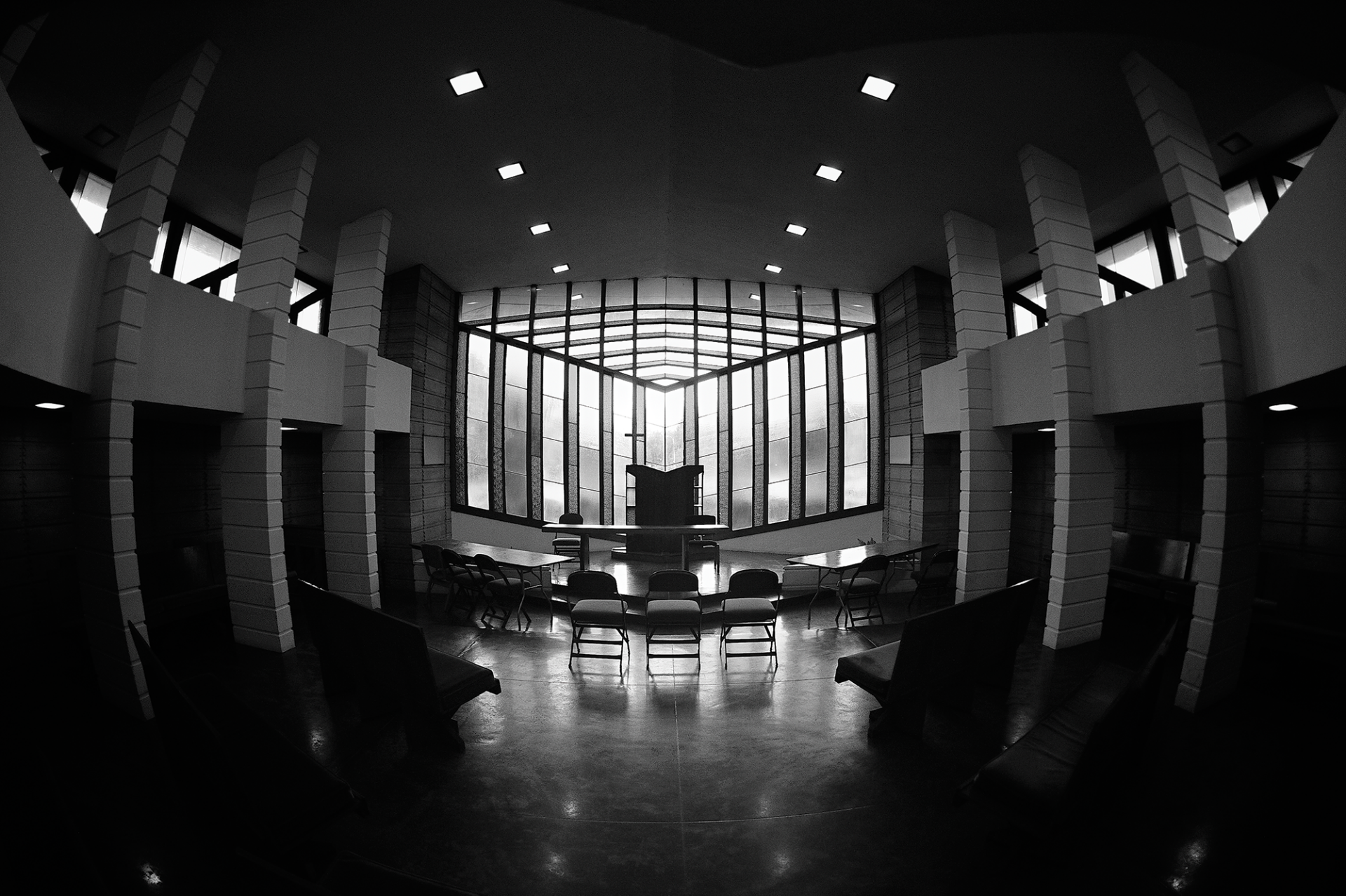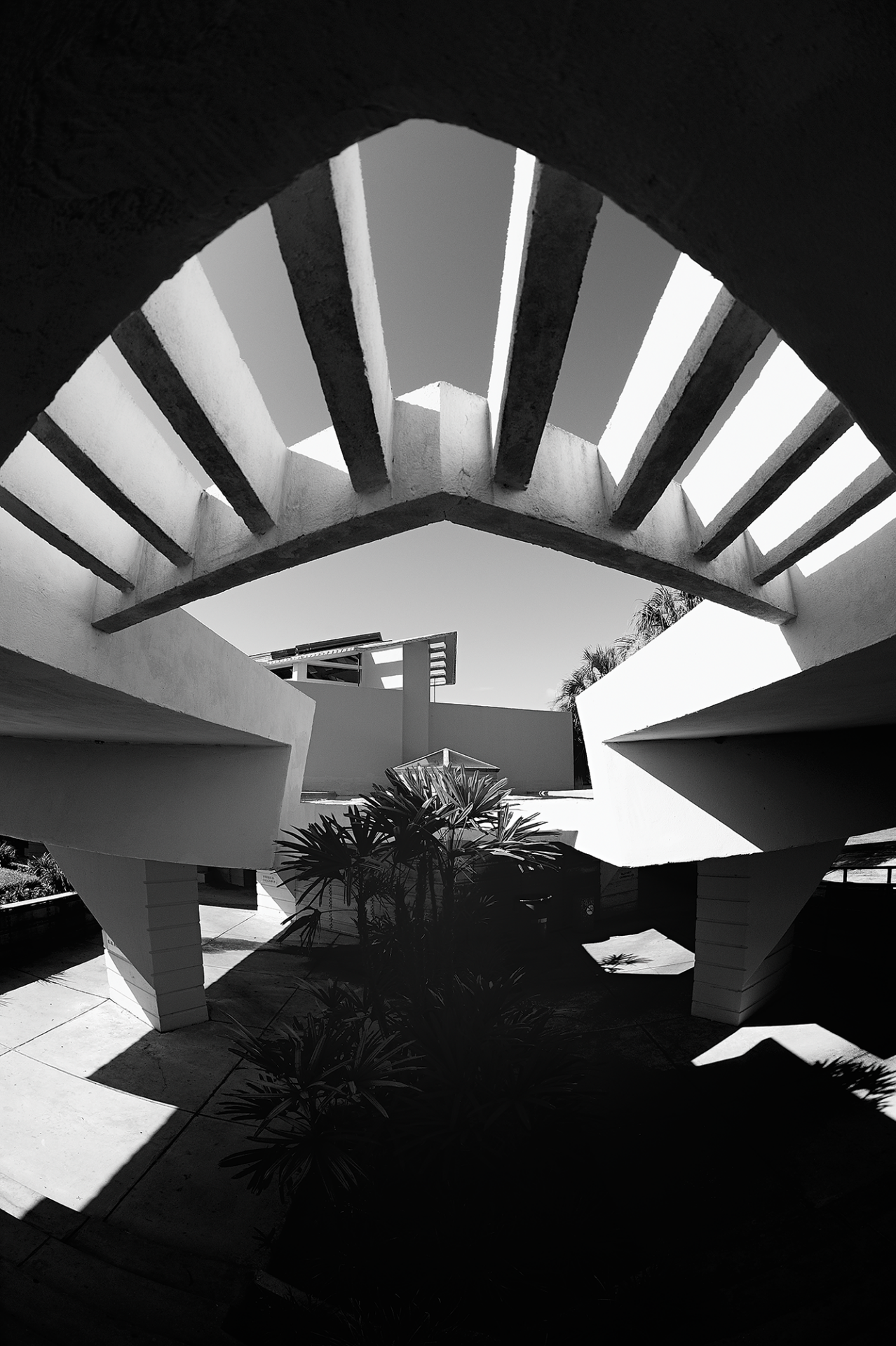Photography by: Thomas K. Mack
Fresh perspective on a modernist classic.
We’ve been told that it is significant, brilliant, the most beautiful, and, most recently, a National Historic Landmark. Many of us know the basics of its story. There’s a strong likelihood you’ve even given directions to a befuddled tourist to it. What exactly is it that makes the Florida Southern College campus so special? Its value lies in one name: Frank Lloyd Wright.
In the 1930s, Dr. Ludd Spivey was leading Florida Southern College through a new era and hoped to create a large campus that would better reflect his overall vision for the school. Spivey’s desire to expand his campus is not surprising. Though the college had been established in 1883, it underwent four location changes and three name changes before evolving into the Florida Southern College on Lake Hollingsworth with which we are familiar today. The college had only been at its Lakeland location since 1922 and comprised just a few buildings. These stately brick buildings did not correspond with Spivey’s grand vision for the campus or goals for the school.
The 1930s, despite the persistence of the Great Depression, also saw the overall student population in the United States expanding, with help from benefits for veterans and federal incentives. More students in college, in theory, meant lower unemployment numbers and fewer people standing in breadlines. Campus populations would boom again after World War II. Spivey’s goals for his campus, then, were not as untimely as they may seem. The college expanded from 500 students in 1938 to 2,300
by 1956.
According to one legend, a member of Dr. Spivey’s faculty suggested that architect Frank Lloyd Wright might be the only person with enough vision to match Spivey’s own. Given Wright’s reputation for his sizeable ego, one can’t help but wonder if the faculty member meant this as a joke. The idea seems to have stuck with the college president, and in 1938 he flew to Taliesin in Spring Green, Wisconsin, to persuade Wright to design the college campus.

Spivey’s fixture on Wright as the potential architect of his great campus is somewhat remarkable. Most college administrators sought architects who would design buildings in the styles deemed “appropriate” for college architecture, usually because of their associations with history — grand Gothic or vaguely Tudor style buildings to resemble England’s great universities; neoclassical architecture for the Greeks; or, if in red brick, Thomas Jefferson’s University of Virginia colonial to appear more like Harvard and other old Ivies; or Romanesque because it literally seemed weightier. The majority of colleges stuck with tradition, and Wright was most definitely not a traditionalist. At the same time, Wright’s type of modernism was not nearly as intimidating as that of his European émigré contemporaries, with their abundance of glass and steel. He espoused the ideas of “organic architecture,” buildings that held a direct relationship with their natural environments.
Frank Lloyd Wright was having a great year in 1938. He was on the rise again in what many architectural historians consider his “second career,” a great feat for a man in his seventies. He had almost overcome the scandals in his personal life that had driven him from the Midwest for nearly two decades. He had designed the January issue of Architectural Forum, which was dedicated to his own work, and he had appeared on the cover of Time magazine. In the three years prior, he had completed what many believe to be some of his greatest works: Fallingwater in 1935, the S.C. Johnson Wax Administration Building in 1936, and Taliesin West in 1937. Why on earth would he accept a commission for a tiny Methodist school in an orange grove in central Florida?
[modula id=”17915″]
For Wright, this was an opportunity to put his ideas about educational architecture and planning to work. He was not being courted to design a single building or two. Spivey was giving him the chance to design a campus in its entirety. At that time, Wright had already published his book on city planning, or rather the movement away from the city, The Disappearing City.
He was also obsessed with his model for the future of the urban landscape, dubbed “Broadacre City.” Broadacre City as an idea centered on deconstructing urban life into lots of small cities connected by one superhighway, each city having buildings located on large plots of land and at a scale more relatable to a man driving in a car or, eventually, his own helicopter. Wright hated cities and thought man required a return to nature, with more light and freedom. When Broadacre City appeared in the New York Times, critics lampooned it for its extreme individualism and its waste of land. Wright was the type of man who had great opinions on how every aspect of a person’s life, from the interior of their homes to the landscape of their cities, could be designed, and he firmly believed his way to be the best. Great artists frequently do. For Florida Southern College, he could put some of his ideas on how to best plan a space, in essence a small city, as well as his ideas about education, to use.

Frank Lloyd Wright accepted, flew to Florida, toured the orange grove, and developed his idea for buildings rising “out of the ground, and into the light, a child of the sun.” The buildings were to incorporate steel for strength, sand as a native material, and glass to bring God’s light of the outdoors into man’s indoor world. While these materials proved to be problematic in the future, Wright’s ability to make his buildings so relatable to their environment that, at their best, they seem to have sprung from the earth itself, was one of the things that made him a genius.
With Florida Southern, we can see Wright’s insistence on forcing mankind to see nature. The buildings and the Esplanades, with the exception of the Annie Pfeiffer Chapel rising to the heavens, have that low horizontality we associate with Wright, but they also reflect the Florida skyline. The sand blocks give them the appearance of having naturally occurred, rather than being inserted onto the landscape — they are in striking contrast to the red brick traditional buildings of the “old campus.” And, of course, there is all that light that Wright so strongly believed mankind desperately needed, glimmering brightly through tiny colored blocks, peeking through clerestory windows, flowing through skylights, illuminating the colored panes at Danforth Chapel, and streaming in brilliantly at Annie Pfeiffer Chapel. Wright’s use of light at Florida Southern is akin to his use of windows at Fallingwater to allow the sound of the waterfalls below to permeate the home. The space called for in Broadacre City is also present, those great distances between buildings to allow them to each occupy their own space.
Ultimately, what makes Florida Southern College so special within Wright’s oeuvre comes down to numbers. You can see more Frank Lloyd Wright buildings at one small school in Lakeland than anywhere else in the world. You can also see a greater variety, and Wright’s ideas about how religious, administrative, and different types of educational buildings should be shaped. You can obtain a real sense of what this individual was so passionate about.
And he just happens to be the person many believe to be the best American architect ever.
